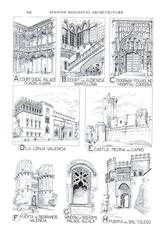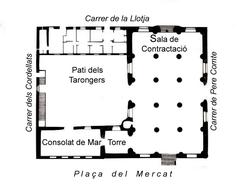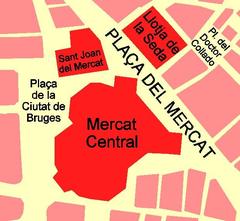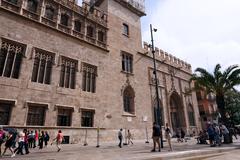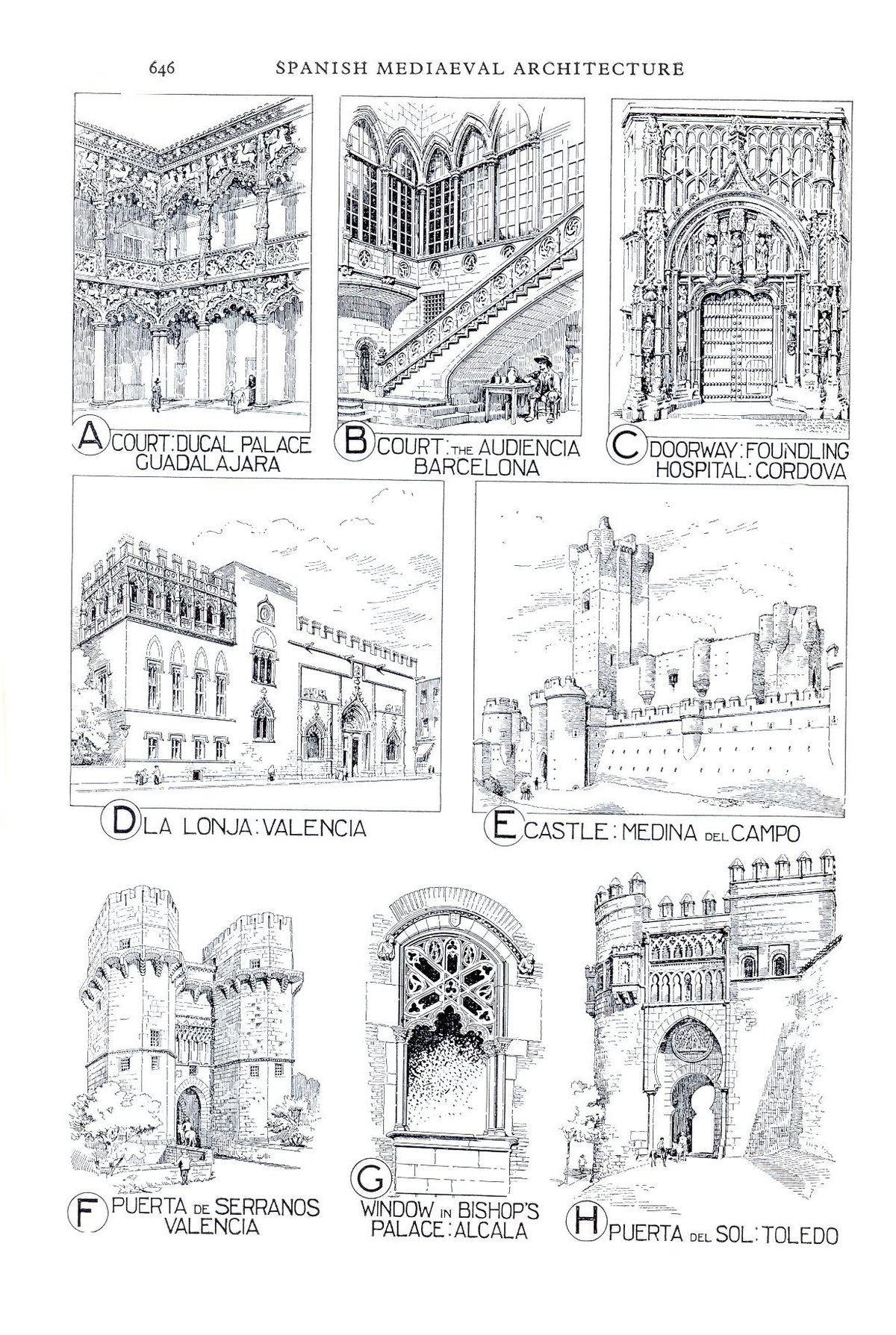
Llotja De La Seda Valencia: Visiting Hours, Tickets, and Historical Guide
Date: 14/06/2025
Introduction: The Legacy of La Llotja de la Seda
Located in the heart of Valencia, Spain, La Llotja de la Seda—also known as the Silk Exchange—stands as an enduring symbol of the city’s mercantile golden age and architectural splendor. Built between 1482 and 1533, this UNESCO World Heritage Site is celebrated as one of the Mediterranean’s preeminent examples of late Gothic civil architecture. Originally the hub of Valencia’s lucrative silk trade, the building today invites visitors to explore its richly adorned halls, intricate carvings, and storied past, offering a window into the city’s economic, artistic, and cultural zenith.
La Llotja’s architectural highlights—such as the Salón Columnario (Contract Hall) with its soaring palm-tree-shaped columns, the tranquil Patio de los Naranjos, and the fortress-like exterior—reflect the city’s prosperity and cosmopolitan character during the late Middle Ages and Renaissance. The building’s continued use for civic events and cultural programming, as well as its excellent state of preservation, underscore its ongoing relevance as both a historical monument and a vibrant community space. For up-to-date details on visiting, events, and heritage status, consult Visit Valencia and UNESCO World Heritage.
Table of Contents
- Historical Context and Significance
- Architectural Features and Layout
- Visitor Information: Hours, Tickets, and Accessibility
- Travel Tips and Nearby Attractions
- Guided Tours and Educational Resources
- Special Events and Exhibitions
- Frequently Asked Questions (FAQ)
- Conclusion and Resources
- References
Historical Context and Significance
Origins and Mercantile Power
La Llotja de la Seda was constructed as Valencia’s silk trade flourished, positioning the city as a major commercial hub within the Mediterranean and the Crown of Aragon. The building served as the principal marketplace for silk, a luxury commodity that helped propel Valencia to economic and cultural prominence (Valencia City Guide). Its architecture and functions reflect the wealth and civic pride of Valencia’s merchant class and the city’s integration into global trade networks.
UNESCO World Heritage Recognition
Designated a National Historic and Artistic Monument in 1931, La Llotja was inscribed as a UNESCO World Heritage Site in 1996 for its outstanding universal value as a masterpiece of late Gothic civil architecture and its role in the region’s historical commerce (UNESCO World Heritage).
Architectural Features and Layout
Salón Columnario (Contract Hall)
The Contract Hall is the building’s most iconic space, featuring eight helicoidal columns rising 17.4 meters, evoking a forest of stone palms. This hall once hosted the city’s Taula de Canvis (municipal bank) and witnessed the first known use of a bill of exchange in Spain. The star-shaped vaulting and interplay of light create a dramatic setting for commercial negotiations (Visit Valencia).
El Torreón (Main Tower)
This adjacent tower served both practical and symbolic roles: its ground-floor chapel provided spiritual support to merchants, while its upper floors housed a debtor’s prison, emphasizing the gravity of commercial agreements.
Pabellón del Consulado (Consulate Pavilion)
Added in the 16th century, this pavilion housed the Tribunal del Mar (maritime court) and is notable for its grand staircase, heraldic stonework, and Mudéjar-influenced artesonado (carved wooden) ceilings.
Patio de los Naranjos (Orange Tree Courtyard)
This serene courtyard, planted with orange trees and surrounded by arcaded galleries, offers visitors a peaceful respite and celebrates Valencia’s agricultural heritage (veebrant.com).
Decorative Details
The building is adorned with intricate Gothic carvings, including 28 enigmatic gargoyles, heraldic shields, vegetal motifs, and friezes depicting civic virtues and religious scenes. Stained glass windows and polychrome wooden ceilings further enhance its artistic value.
Construction Techniques and Materials
Built using locally quarried limestone, La Llotja’s structural system employs columns, pointed arches, and ribbed vaults to create vast, open spaces without intermediate supports—a testament to Gothic engineering (Visit Valencia).
Visitor Information: Hours, Tickets, and Accessibility
Opening Hours
- Monday to Sunday: 10:00 AM – 7:00 PM (last entry at 6:30 PM)
- Free entry: Sundays and public holidays
- Closed: Major public holidays (e.g., January 1, December 25)
Check the official site for seasonal updates.
Tickets and Pricing
- General Admission: €2–€2.50
- Reduced Admission: €1–€1.50 (students, seniors, large families)
- Children under 10–12: Free
- Free for Valencia residents: On presentation of ID
Tickets may be purchased on-site or online through the official portal.
Accessibility
While the ground floor and main entrance are wheelchair accessible, some upper-floor areas remain inaccessible due to historic staircases. Ramps and elevators are available where feasible. Sign language guides and assisted services can be requested at the ticket office.
Facilities
Restrooms are available on site. There is no café within the monument, but the surrounding Old Town offers abundant dining options.
Travel Tips and Nearby Attractions
- Best Time to Visit: Early morning (10:00–11:00 AM) or late afternoon to avoid larger crowds and enjoy optimal lighting.
- Ideal Seasons: Spring and autumn offer pleasant weather and fewer tourists.
- Location: Carrer de la Llotja, 2, 46001 Valencia—adjacent to Mercat Central and within walking distance of Valencia Cathedral and Plaza Ayuntamiento.
- Nearby Attractions:
- Mercado Central: Europe’s largest covered market.
Explore on foot or incorporate the Silk Exchange into a broader cultural itinerary for a comprehensive experience.
Guided Tours and Educational Resources
- Audio Guides: Available in multiple languages for a nominal fee.
- Guided Tours: Multilingual tours can be booked online or through local operators, including specialized “Silk Trade” and UNESCO-focused tours.
- Educational Programs: The monument regularly hosts workshops, exhibitions, and lectures tailored to schools, universities, and cultural groups (Time Travel Turtle).
Special Events and Exhibitions
La Llotja de la Seda frequently hosts seasonal exhibitions, cultural events, and concerts. For the latest schedule and to plan your visit around unique experiences, consult the official events calendar.
Frequently Asked Questions (FAQ)
Q: What are the visiting hours for Llotja de la Seda?
A: Open daily from 10:00 AM to 7:00 PM (last entry at 6:30 PM); free entry on Sundays and public holidays.
Q: How much are tickets?
A: €2–€2.50 for adults; €1–€1.50 for discounted categories; free for children under 10–12 and on Sundays/public holidays.
Q: Is the building wheelchair accessible?
A: Partial accessibility—main entrance and ground floor are accessible, but upper floors lack elevator access.
Q: Are guided tours available?
A: Yes, both audio guides and guided tours in multiple languages can be booked online or on-site.
Q: Can I take photos inside?
A: Yes, non-flash photography is permitted.
Q: What else should I see nearby?
A: Mercado Central, Valencia Cathedral, and Plaza Ayuntamiento are all within easy walking distance.
Conclusion and Resources
La Llotja de la Seda is an architectural marvel and cultural treasure at the heart of Valencia, offering visitors a journey through the city’s mercantile power, artistic innovation, and enduring civic pride. With affordable tickets, convenient hours, and rich programming, it stands as a must-see for history enthusiasts and casual travelers alike. Enhance your visit by downloading the Audiala app for interactive guides and real-time updates (Audiala App), and check official channels for the latest news, events, and visitor information.
References
- La Llotja de la Seda: Visiting Hours, Tickets, and Guide to Valencia’s Historic Silk Exchange, 2025, Valencia City Guide
- Llotja de la Seda (Silk Exchange) in Valencia: Architecture, Visitor Info, and Tips for Your Visit, 2025, Visit Valencia
- Llotja De La Seda Visiting Hours, Tickets, and Cultural Significance in Valencia, 2025, World Heritage Sites Net
- Visitor Experience and Practical Information, 2025, Visit Valencia
- UNESCO World Heritage List - La Lonja de la Seda, 2025, UNESCO
